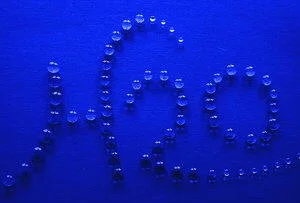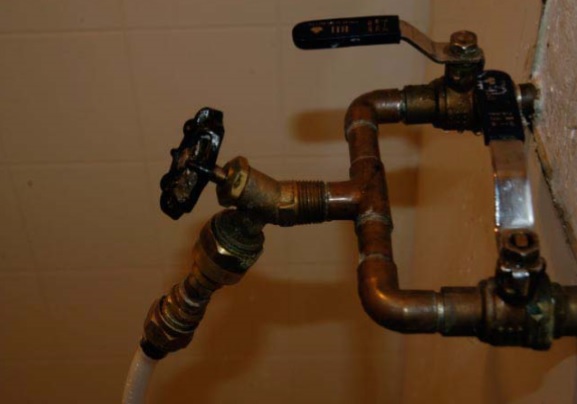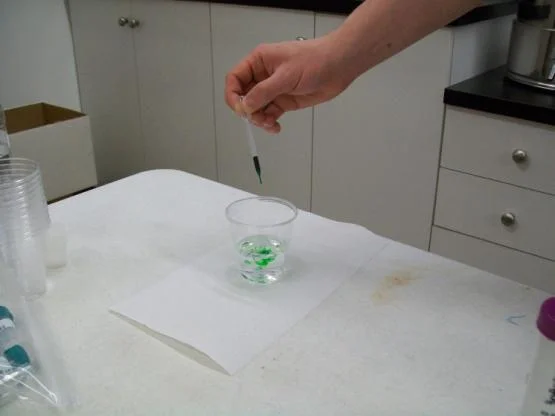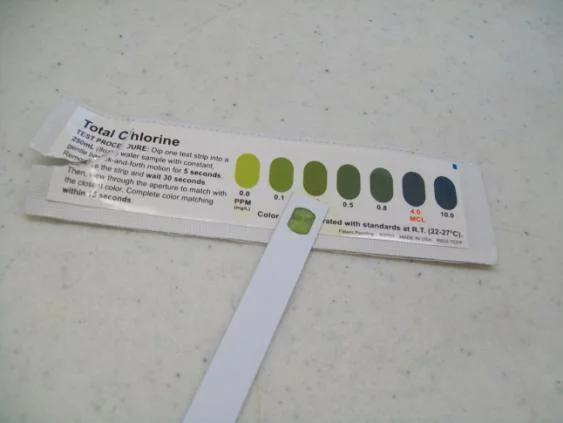Operation Water Drop
High School Operation Water Drop is for students in grades nine to twelve and enables them to test their local drinking water, control water samples, and three other water samples (we recommend urban, rural, and raw water samples) for 12 different components: alkalinity, ammonia, arsenic, total chlorine, colour, copper, iron, manganese, nitrate, pH, sulphate, and total hardness.
Elementary Operation Water Drop is for students in grades four to eight and enables them to test their local drinking water and control water samples for eight different components: alkalinity, ammonia, total chlorine, colour, copper, pH, sulphate, and total hardness.
In both cases, students compare their results to the Guidelines for Canadian Drinking Water Quality and are encouraged and supported in sharing what they learned with others and alleviating drinking water quality issues in their regions.
If your treated tap water test results are not within the Guidelines for Canadian Drinking Water Quality, please follow these steps:
If you have multiple kits, compare your results for that specific test with your other results for that water sample for that same component.
Visit the section on our website that contains information about finding your community’s water quality test results. See whether the most recent test results confirm or refute your findings. If they confirm your results, contact your local water systems operator to discuss whether the issue still exists.
If it has been determined that there is an issue with the tap water in your community, share information with others and advocate for change.
Generally, sponsored Operation Water Drop kits are sent to schools every second Monday from mid-September until the beginning of November and the beginning of March until the end of May. Purchased kits are usually sent on the same dates, but teachers can request that they be sent as soon as possible and we will do our best to accommodate their request.
Cost
The cost of an Elementary OWD kit is $85 and includes all of the materials necessary to test your local drinking water and control water samples for eight different components. The cost of a High School OWD kit is $170 and includes all of the materials necessary to test five different water samples for 12 different components (60 tests in total!). Many school kits are available free of charge as a result of different sponsors. However, if there is not a sponsored kit available for your school or you want a kit right away it is best to purchase a kit.
Or, phone us at 1-306-934-0389 to pay for your kit with Visa or MasterCard.
Or, mail a cheque payable to Safe Drinking Water Foundation to:
Safe Drinking Water Foundation
#1-912 Idylwyld Drive North
Saskatoon, SK S7L 0Z6
A Note About Disposal
After the testing has been completed, everything can be poured down the tap as even the arsenic test is within limits of safety. However, if you are concerned and are able to do so, you could take the solutions to a local waste disposal facility or university chemistry department.
A Note About Plastic Cups and Beakers
The kits are now available with less plastic - you can select this option when requesting sponsored kits or when purchasing kits (you get a 10% discount!). If students make errors, and you want to reuse the plastic beakers or the plastic cups, please rinse the beaker or cup with the provided deionized water twice and then reuse it.
Essential Links for Using Elementary Operation Water Drop kits
There are 8 tests to be run in this kit, teachers will demonstrate 2 different tests, and these tests are: Alkalinity and Sulphate. The students can do the other 6 tests with a minimal amount of help, these tests are: Ammonia, pH, Colour, Copper, Total Chlorine, and Total Hardness.
Results: Since there is no Canadian Drinking Water Guideline for Ammonia you will compare results to the European Union limit. The standard should give a result very close to the 0.5 mg/L colour; if the colour is darker then it DOES NOT meet the guidelines.
Students enter their results for the tests: alkalinity, ammonia, colour, copper, pH, sulphate, total chlorine, and total hardness. Students compare their results to the Guidelines for Canadian Drinking Water Quality.
Essential Links for Using High School Operation Water drop kits
To allow students to run tests on five different sources of water. Students are expected to collect three samples of water: Urban and Rural (includes Aboriginal and non-Aboriginal communities) treated waters, and a Raw Source Water.
1. One bottle contains 5 micrograms/L arsenic. Put 100 mL of water sample in the second plastic bottle with lid (not the flip top type). Water should be room temperature (20-25 degrees C).
Students enter their test results for the five water samples. Students enter their results for alkalinity, ammonia, arsenic, colour analysis, copper, iron, manganese, nitrate, pH, sulphate, total chlorine and total hardness.
Simplified instructions, with information about why each component is important, and QR codes for all the PowerPoint instructions and videos - so your students can scan the QR codes with their smartphones! You might want to print this document double-sided, then you just have one sheet for each test!
OVERVIEW MATERIALS FOR BOTH ELEMENTARY AND HIGH SCHOOL
Curriculum connections for grades four to twelve all across Canada.
Alberta Grade Nine Science
Unit C: Environmental Chemistry (Social and Environmental Emphasis)
2: Identify processes for measuring the quantity of different substances in the environment and for monitoring air and water quality
1. Put the students into groups of 3-5. 2. Provide the students with the "Not In My Backyard?" handout. 3. Have the students define the problem and determine what they know about the problem, what they need to learn more about, and where they need to look to find information. 4. Groups conduct research, find information, and work towards deciding what they should do. The teacher acts as a metacognitive coach, serving as a model.
1. The first thing you are going to want to do with your Operation Water Drop kit is to use it. Test the water samples you have been given and your local drinking water (as well as three other water samples such as urban, rural and raw water, in the case of High School Operation Water Drop kits) with the kit’s contents. Record these test results.
I have used this program for quite a few years now, and have tried a variety of methods in delivering the hands-on aspects of testing our own water. What follows are some of my observations and preferences based on my classroom facilities, my students and my time frame.
SDS sheets for chemicals in Operation Water Drop kits. Includes SDS sheets for acetic acid, glacial; ammonia standard 1000 ppm; arsenic standard; arsenic reagents and testing pad; barium chloride dihydrate; copper standard 1000 ppm; iron ferro reagent; iron standard 1000 ppm; magnesium chloride hexahydrate; manganese 1000 ppm; methyl purple indicator; pH 7 buffer solution; potassium nitrate; sodium acetate trihydrate; sodium sulfate anhydrous; and sulfuric acid.
Operation Water Drop Crossword Puzzle and Answer Key. Across 1: 1 A grayish hard white metal that resembles iron. Down 2: A measure of the ability of your water to resist changes in pH.
ELEMENTARY SCHOOL LESSONS
Curriculum connections for grades four to twelve all across Canada.
Alberta Grade Nine Science
Unit C: Environmental Chemistry (Social and Environmental Emphasis)
2: Identify processes for measuring the quantity of different substances in the environment and for monitoring air and water quality
1. Put the students into groups of 3-5. 2. Provide the students with the "Not In My Backyard?" handout. 3. Have the students define the problem and determine what they know about the problem, what they need to learn more about, and where they need to look to find information. 4. Groups conduct research, find information, and work towards deciding what they should do. The teacher acts as a metacognitive coach, serving as a model.
1. The first thing you are going to want to do with your Operation Water Drop kit is to use it. Test the water samples you have been given and your local drinking water (as well as three other water samples such as urban, rural and raw water, in the case of High School Operation Water Drop kits) with the kit’s contents. Record these test results.
There are 8 tests to be run in this kit, teachers will demonstrate 2 different tests, and these tests are: Alkalinity and Sulphate. The students can do the other 6 tests with a minimal amount of help, these tests are: Ammonia, pH, Colour, Copper, Total Chlorine, and Total Hardness.
Results: Since there is no Canadian Drinking Water Guideline for Ammonia you will compare results to the European Union limit. The standard should give a result very close to the 0.5 mg/L colour; if the colour is darker then it DOES NOT meet the guidelines.
Groundwater - found below the ground where it accumulated in between soil and rocks. The volume of water can range from small to very large similar to above ground creeks, rivers and lakes.
There are 8 tests to be run in this kit, teachers will demonstrate 2 different tests, and these tests are: Alkalinity and Sulphate. The students can do the other 6 tests with a minimal amount of help, these tests are: Ammonia, pH, Colour, Copper, Total Chlorine, and Total Hardness.
Students enter their results for the tests: alkalinity, ammonia, colour, copper, pH, sulphate, total chlorine, and total hardness. Students compare their results to the Guidelines for Canadian Drinking Water Quality.
In your city, the drinking water was being inspected. After thorough inspection of your city’s water supply, there was data collected on many different aspects of your water supply. As the health and safety inspector it is your job to look through this data and find anything that may be hazardous to the public.
To determine how much alkalinity a sample contains using a colourimetric method. Testing will be done on a Local Community Treated Water sample; the teacher will do this as a demonstration.
1. Cover the area that you are working on with paper and use gloves as the Methyl Purple Indicator that you will be using may stain. 2. Label the 2 plastic cups as follows; label one cup Alkalinity LLS and the other cup Local Community Treated Water.
To examine how the concentration of ammonia influence the water quality using the test strip and AEUL. Testing will be done on a Local Community Treated Water sample.
Results: Since there is no Canadian Drinking Water Guideline for Ammonia you will compare results to the European Union limit. The standard should give a result very close to the 0.5 mg/L colour; if the colour is darker then it DOES NOT meet the guidelines.
To determine if the water sample meets Canadian Drinking Water Guidelines for Colour. Testing will be done on Local community treated water. The Canadian Drinking Water Guidelines has an aesthetic objective of 15 TCU (True Colour Units) for drinking water; you will test and compare your result to see if it meets these guidelines.
1. Label the test tubes; Control, Canadian Guideline, and Local community sample. 2. Pour the 50 mL of Canadian Guideline Limit Sample into the Canadian Guideline test tube.
To determine the Copper concentration of a sample. Testing will be done on a Local Community Treated Water sample and a Canadian Guideline Limit Sample for quality control purposes.
1. Label the two beakers with their appropriate water sample names. 2. Put 10 mL of sample in their respective beakers.
To determine if the water sample meets the Canadian Drinking Water Guideline for pH by determining its level of pH. Testing will be done on Local community treated water. There will be a pH 7 buffer solution included for quality control purposes.
1. Label the three beakers with their respective names (do not include the buffer; this can be tested in the tube). 2. Fill the beakers with their respective samples.
To determine if the water sample meets Canadian Drinking Water Guideline for Sulphate making a visual comparison of precipitate present. Testing will be done on Local community treated water; the teacher will do this as a demonstration.
3. Using a graduated cylinder, measure out 25 mL of Deionized Water to each of the 3 cups.
To determine the total chlorine concentration in your local drinking water. Find two different locations (drinking water fountain, tap water from the gym etc.) and sample the water into cups provided, label the cups from where the water came before you sample.
1. Label the two glasses with their respective names. 2. Put about 50 mL of sample in respective glasses (volume is really not critical).
To determine the Total Hardness concentration in drinking water on a Local Community treated water and a Saskatchewan Guideline Limit Sample (SGLS) for quality control purposes.
1. Label the two beakers with their respective names.
2.Put 10 mL of sample in their respective beakers.
Elementary Operation Water Drop Student Presentations Evaluation. Students are evaluated based on their knowledge/understanding, thinking/inquiry, communication, learning organization skills, and learning teamwork skills.
HIGH SCHOOL LESSONS
Curriculum connections for grades four to twelve all across Canada.
Alberta Grade Nine Science
Unit C: Environmental Chemistry (Social and Environmental Emphasis)
2: Identify processes for measuring the quantity of different substances in the environment and for monitoring air and water quality
1. Put the students into groups of 3-5. 2. Provide the students with the "Not In My Backyard?" handout. 3. Have the students define the problem and determine what they know about the problem, what they need to learn more about, and where they need to look to find information. 4. Groups conduct research, find information, and work towards deciding what they should do. The teacher acts as a metacognitive coach, serving as a model.
1. The first thing you are going to want to do with your Operation Water Drop kit is to use it. Test the water samples you have been given and your local drinking water (as well as three other water samples such as urban, rural and raw water, in the case of High School Operation Water Drop kits) with the kit’s contents. Record these test results.
To allow students to run tests on five different sources of water. Students are expected to collect three samples of water: Urban and Rural (includes Aboriginal and non-Aboriginal communities) treated waters, and a Raw Source Water.
1. One bottle contains 5 micrograms/L arsenic. Put 100 mL of water sample in the second plastic bottle with lid (not the flip top type). Water should be room temperature (20-25 degrees C).
Tips and advice regarding how to use the High School Operation Water Drop kit in your classroom. There are two methods to go about it - in one method different groups of students test for different components in all of the water samples, in the other method each group of students tests for all of the different components in one water sample.
Groundwater - found below the ground where it accumulates in between soil and rocks. The volume of water can range from small to very large similar to above ground creeks, rivers and lakes, found in bodies of water that resemble underground lakes called aquifers.
To allow students to run tests on five different sources of water. Students are expected to collect three samples of water: Urban and Rural (includes Aboriginal and non Aboriginal communities) treated waters, and a Raw Source Water.
Students enter their test results for the five water samples. Students enter their results for alkalinity, ammonia, arsenic, colour analysis, copper, iron, manganese, nitrate, pH, sulphate, total chlorine and total hardness.
There is no Canadian Drinking Water Guideline for Alkalinity in drinking water, but it is an important characteristic of the water and if your local community water is less than the LLS then the water may be quite corrosive, which may result in increased levels of copper and lead leached out from household plumbing.
1. Cover the area that you are working on with paper and use gloves as the Methyl Purple Indicator that you will be using may stain. 2. Label the 5 plastic cups as follows: #1 Alkalinity LLS, #2 Urban Treated Water, #3 Rural Treated Water, #4 Untreated Raw Water, #5 Local Community Treated Water.
Ammonium is a reduced form of nitrogen (NH 4 + ) and together with the non-ionized form (NH 3 ) they compose ammonia. Ammonia is frequently present in groundwater sources where there is no oxygen present.
Ammonium is a reduced form of nitrogen (NH 4 + ) and together with the non-ionized form (NH 3 ) they compose ammonia. Ammonia is frequently present in groundwater sources where there is no oxygen present.
Please Note: If high levels of hydrogen sulphide are present in the water sample (as is the case with some raw water samples) please expose the water sample to air for eight hours before doing the arsenic test in order to prevent an arsenic test "eruption" in your classroom!
Please Note: If high levels of hydrogen sulphide are present in the water sample (as is the case with some raw water samples) please expose the water sample to air for eight hours before doing the arsenic test in order to prevent an arsenic test "eruption" in your classroom!
The Canadian Drinking Water Guidelines has an aesthetic objective of 15 TCU (True Colour Units) for drinking water; you will see and compare the different water sources. The 15 TCU (True Colour Units) is the concentration of the Canadian Guideline sample.
1. Label the test tubes with their number and appropriate name; #1 Control, #2 Canadian Guideline, and #3, #4, #5, #6. 2. Pour the 50 mL of Canadian Guideline into the #2 test tube.
Copper is naturally present in the environment, but the levels of contamination can be increased around agricultural land (manure spreading), near smelting facilities, and phosphate fertilizer plants, there is also significant amounts of copper released from wastewater treatment plants. The copper piping in most buildings that we consume water from also can contribute to our intake, depending on the corrosiveness of the water.
1. Label the five beakers with their appropriate water sample names. 2. Put 10 mL of sample in their respective beakers.
The direct health implications of iron are very limited, there are however indirect problems some of which are: colour, which comes from iron in a particulate form which is too small to filter so you get “coloured water”, iron bacteria, this is when bacteria and iron form a slime which can lead to poor pipe flow, this can occur when the iron concentration exceeds 0.3 mg/L, the Canadian Drinking Water Guideline (CGLS).
1. Label five beakers with their respective names: Urban Treated Water, Rural Treated Water, Untreated Raw Water, Local Community Treated Water, Canadian Guideline Limit Sample for Iron (CGLS). 2. Put 10 mL of a water sample or (CGLS) in their respective beakers.
Most countries, including Canada, have set an aesthetic rather than a health guideline for manganese. The reason for this is that levels above the guideline can stain porcelain and laundry, drinks such as coffee and tea can become cloudy and taste funny. High manganese levels can also cause diarrhea.
1. Label the four clear plastic vials with the names of the water samples to be tested. 2. Test the Manganese CGLS sample first.
There are many negative health effects related to Nitrate, some of which include blood deficiencies, thyroid problems, decreased vitamin A, and cancer. It is, however, rare that nitrate levels are above the Canadian Water Quality Guideline for drinking water. Contaminated private wells are likely the most common place where high levels of nitrate are found.
1. Label the four beakers with their respective names (no CGLS). 2. Put 10 mL of sample in their respective beakers; use the vial for the Canadian Guideline Limit Sample test.
pH is an index of the amount of hydrogen ions (H+) that are in a substance. The pH scale runs from 0-14, with 7.0 being neutral. Substances with a pH higher than 7.0 (7.1-14.0) are considered alkaline or basic.
1. Label the four beakers with their respective sample names (do not include the buffer; this can be tested in the tube). 2. Fill the beakers with their respective samples.
The current limits for sulphate in drinking water are based on aesthetic objectives and are set at <500mg/L, which is the taste threshold level.
4. To the #1 cup, add 2 mL of Deionized Water using the pipette labeled #1 or DI. 5. To the #1 cup, add contents of one of the Sulphate Reagent #1 tubes.
Studies have shown that when total chlorine levels drop below recommendations, several water quality problems can occur. With regard to public health, bacteria and selected viruses, called bacteriophages, are able to multiply in water that is not properly disinfected and, depending on the species, could potentially cause waterborne illnesses
1. Label the five glasses with their respective names. 2. Put about 50 mL of sample in respective glasses (volume is really not critical).
Total hardness is a measurement of calcium, magnesium, and is expressed as calcium carbonate; our body needs both Ca and Mg to remain healthy. The direct health effects are unknown because very little research has been done on the effects of hard water consumption.
1. Label five beakers with their respective names. 2. Put 10 mL of sample in their respective beakers.
High School Operation Water Drop Student Presentations Evaluation. Students are evaluated based on their knowledge/understanding, thinking/inquiry, communication, learning organization skills, and learning teamwork skills.
Simplified instructions, with information about why each component is important, and QR codes for all the PowerPoint instructions and videos - so your students can scan the QR codes with their smartphones! You might want to print this document double-sided, then you just have one sheet for each test!
DOWNSTREAM
Watch the Downstream Film and Panel Discussion Webinar. Downstream is the story of how Dr. O'Connor fought for those living in Fort Chipewyan who were dying from rare forms of cancer.
This lesson should follow a lesson on colonialism. Focus on how colonialism is a part of Canada’s past as well as Canada’s present. Try to avoid talking about those individuals who lost or those individuals who won. Instead focus on what happened, what is happening and what we can do to create positive change.
5. What do you think should be done about the environmental impact that the oil industry has on the environment in Alberta? 7. If you were to give this film a different title what would you call it? Why?
1. Who filed charges against Dr. O’Connor? Alberta Health & Wellness, Health Canada and Environment Canada 2. What is dumped into tailings ponds? Water, clay, silt & naphthoic acid































































